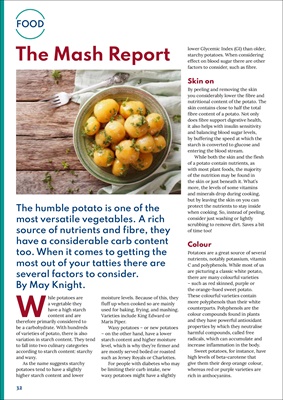
32
FOOD
The Mash Report
The humble potato is one of the
most versatile vegetables. A rich
source of nutrients and fibre, they
have a considerable carb content
too. When it comes to getting the
most out of your tatties there are
several factors to consider.
By May Knight.
While potatoes are
a vegetable they
have a high starch
content and are
therefore primarily considered to
be a carbohydrate. With hundreds
of varieties of potato, there is also
variation in starch content. They tend
to fall into two culinary categories
according to starch content: starchy
and waxy.
As the name suggests starchy
potatoes tend to have a slightly
higher starch content and lower
moisture levels. Because of this, they
fluff up when cooked so are mainly
used for baking, frying, and mashing.
Varieties include King Edward or
Maris Piper.
Waxy potatoes - or new potatoes
- on the other hand, have a lower
starch content and higher moisture
level, which is why they're firmer and
are mostly served boiled or roasted
such as Jersey Royals or Charlottes.
For people with diabetes who may
be limiting their carb intake, new
waxy potatoes might have a slightly
lower Glycemic Index (GI) than older,
starchy potatoes. When considering
effect on blood sugar there are other
factors to consider, such as fibre.
Skin on
By peeling and removing the skin
you considerably lower the fibre and
nutritional content of the potato. The
skin contains close to half the total
fibre content of a potato. Not only
does fibre support digestive health,
it also helps with insulin sensitivity
and balancing blood sugar levels,
by buffering the speed at which the
starch is converted to glucose and
entering the blood stream.
While both the skin and the flesh
of a potato contain nutrients, as
with most plant foods, the majority
of the nutrition may be found in
the skin or just beneath it. What's
more, the levels of some vitamins
and minerals drop during cooking,
but by leaving the skin on you can
protect the nutrients to stay inside
when cooking. So, instead of peeling,
consider just washing or lightly
scrubbing to remove dirt. Saves a bit
of time too!
Colour
Potatoes are a great source of several
nutrients, notably potassium, vitamin
C and polyphenols. While most of us
are picturing a classic white potato,
there are many colourful varieties
- such as red skinned, purple or
the orange-hued sweet potato.
These colourful varieties contain
more polyphenols than their white
counterparts. Polyphenols are the
colour compounds found in plants
and they have powerful antioxidant
properties by which they neutralise
harmful compounds, called free
radicals, which can accumulate and
increase inflammation in the body.
Sweet potatoes, for instance, have
high levels of beta-carotene that
give them their deep orange colour,
whereas red or purple varieties are
rich in anthocyanins.